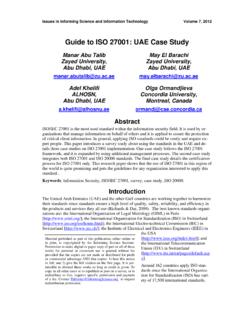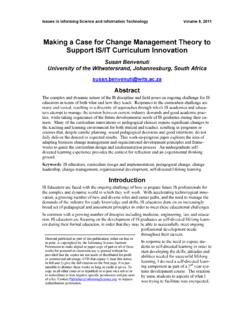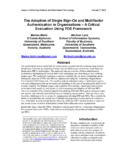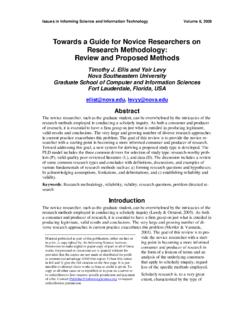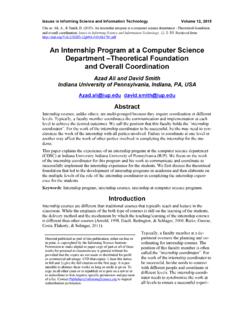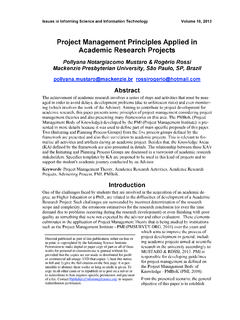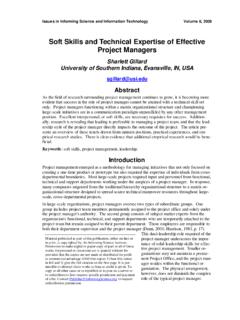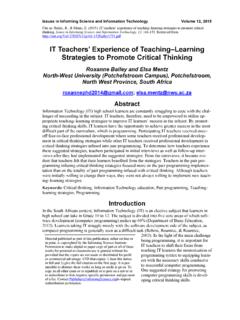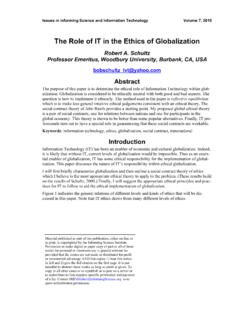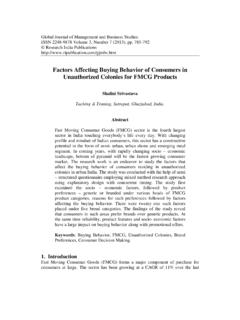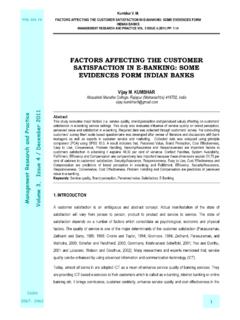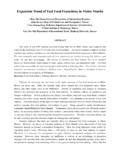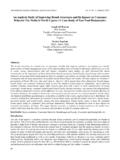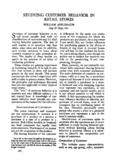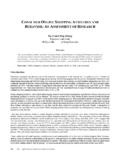Transcription of The Use of Mobile Phones by South African University Students
1 Issues in Informing Science and Information Technology Volume 11, 2014 Cite as: North, D., Johnston, K., & Ophoff, J. (2014). The use of Mobile Phones by South African University Students . Issues in Informing Science and Information Technology, 11, 115-138. Retrieved from The Use of Mobile Phones by South African University Students David North, Kevin Johnston, and Jacques Ophoff University of Cape Town, South Africa Abstract Mobile Phones are an integral part of our modern lives. This study explores the use and role of Mobile Phones among South African University Students . Four main categories are used to exam-ine the Students Mobile phone use: reasons to use Mobile Phones , pattern of Mobile phone use, purchasing factors , and behaviour-related issues. Through a quantitative approach data was col-lected from 362 participants using a survey. The key findings indicate that the main reason South African University Students (mainly from the University of Cape Town) use a Mobile phone is for socializing, as well as for safety and privacy purposes.
2 Usability and price emerged as the top purchasing factors . The respondents showed some signs of addiction to their Mobile Phones . Differences in Mobile phone use by gender were found, with female Students showing increased Mobile phone use for safety and socializing, inter-est in brand and trends, as well as signs of addiction. The findings could prove beneficial to mar-keters, Mobile phone developers, universities, parents, and researchers exploring Mobile phone adoption and usage pattern in a developing country such as South Africa. Keywords: Mobile phone , reasons to use, usage patterns, purchasing factors , behavioural issues, gender differences Introduction In the 21st century the Mobile phone is an integral part of everyday life, only found strange when it is absent. As stated by Katz and Aakhus (2002), the spread of Mobile Phones is affecting peo-ple s lives and relationships and affects how people interact when face to face or, rather and in-creasingly, face-to-face-to- Mobile - phone -face, since people are ever more likely to include the Mobile phone as a participant in what would otherwise be a face-to-face dyad (p.)
3 31). This study aims to discover the patterns of how South African University Students use Mobile Phones in their daily lives. This is deemed interesting and relevant because South Africa has a Mobile penetration rate of over 100%, consisting of a rich diversity of Mobile Phones ranging from entry-level feature Phones to smart- Phones (International Telecommunica-tion Union, 2013). The study looks at four main themes of Mobile phone use: reasons to use Mobile Phones (socialis-ing, safety, privacy and status), pattern Material published as part of this publication, either on-line or in print, is copyrighted by the Informing Science Institute. Permission to make digital or paper copy of part or all of these works for personal or classroom use is granted without fee provided that the copies are not made or distributed for profit or commercial advantage AND that copies 1) bear this notice in full and 2) give the full citation on the first page.
4 It is per-missible to abstract these works so long as credit is given. To copy in all other cases or to republish or to post on a server or to redistribute to lists requires specific permission and payment of a fee. Contact to request redistribution permission. Use of Mobile Phones by South African University Students of Mobile phone use (average number of calls made and received daily etc.), purchasing factors (brand, trend, price, aesthetic values, usability), and behaviour related issues (addiction, using Mobile Phones in lectures, driving) (Balakrishnan & Raj, 2012). Mobile Phones are known to be very popular among University Students , increasing their social inclusion and connectedness as well as providing a sense of security as they can contact others in times of distress or emergency (Balakrishnan & Raj, 2012). Although there are many benefits of using a Mobile phone , there can also be negative effects on the users and environment.
5 Lectures are disrupted when Mobile Phones are used at inappropriate times (Walsh et al., 2010), and using a Mobile phone whilst driving may lead to an increased risk of an accident (Hong, Chiu, & Huang, 2012; Walsh et al., 2010). Other negative consequences of Mobile phone use include ad-diction, manifested as over dependency, which can cause problems such as emotional stress, damaged relationships, and falling literacy (Balakrishnan & Raj, 2012). According to Walsh et al. (2008, 2010) University Students were reported to show signs of cognitive salience, whereby stu-dents think about their Phones when they are not using them, as well as behavioural salience, whereby the Students constantly check their Mobile Phones for missed calls or messages. The research was a quantitative study whereby University Students were asked to complete a sur-vey which was initially designed by Balakrishnan and Raj (2012) to explore the relationships be-tween Malaysian youth and their Mobile Phones .
6 The rest of the paper is presented as follows. In the next section the related literature is reviewed, motivating the research questions on which the study is based. The third section presents the research methodology and the following section presents the research results. The fifth section presents the findings of the study before a conclu-sion is drawn in the last section. Literature related to Mobile phone use Many studies have looked at Mobile phone use amongst University Students in other (not South Africa) countries (Balakrishnan & Raj, 2012; Baron & Campbell, 2010; Beaver, Knox, & Zus-man, 2010; Hong et al., 2012; Ling & Horst, 2011; Lobo & Joshma, 2013; Ogunyemi, 2010; Suominen, Hyrynsalmi, & Knuutila, 2014; Walsh et al., 2010). Within South Africa research done by Kreutzer (2009) focused on the use of Mobile Phones by low-income youth. Apart from a study by Chigona, Kamkwenda and Manjoo (2008) which focused on the use of Mobile Internet, no definitive literature on how South African University Students use and perceive Mobile Phones has been found.
7 The literature review therefore focuses on the use of Mobile Phones by University Students from different parts of the world and how Mobile phone usage is perceived by University Students . It is acknowledged that it is difficult to draw conclusive arguments of Mobile phone use as culture, values, and belief systems differ around the world and play a part in the perception and use of technology. Uses and Gratification Theory Motivations to use technology, ranging from radio and television to digital TV and now the inter-net and Mobile Phones , can be explained by the Uses and Gratification theory (UGT) (Shao, 2009; Shin, 2010). UGT focuses on why consumers turn to technology to satisfy their social and psychological needs (Balakrishnan & Raj, 2012). UGT implies that consumers are actively in-volved in their decision to use, and how to use technology in order to fulfil certain needs (Leung & Wei, 2000; Leung, 2007).
8 UGT is considered one of the most appropriate perspectives for investigating why audiences choose to deal with different technologies (Balakrishnan & Raj, 2012; Shao, 2009). As stated by Shao, whenever a new technology enters the stage of mass communication, people s motivations to use this technology have been examined through this perspective 2009, ). 116 North, Johnston, & Ophoff Previous studies used UGT to examine the gratifications and use of Mobile Phones in University Students (Auter, 2007; Balakrishnan & Raj, 2012; Dresler-Hawke & Mansvelt, 2008; Grellhesl & Punyanunt-Carter, 2012; Leung & Wei, 2000; Leung, 2007; Ogunyemi, 2010). Results suggest a large number of gratifications for Mobile phone use which include: information exchange, con-versation and socializing, information viewing, entertainment, education, escape and diversion, reassurance, fashion and status (Balakrishnan & Raj, 2012; Grellhesl & Punyanunt-Carter, 2012; Leung, 2007; Ogunyemi, 2010).
9 The sections that follow explore the use of Mobile Phones by University Students , using a UGT framework as shown in Figure 1. According to Balakrishnan and Raj (2012), four main catego-ries were identified, namely, reasons to use Mobile Phones , pattern of Mobile phone usage, pur-chasing factors and behaviour related issues. Some of the example items for each of these catego-ries are shown in the framework (p. 266). The literature review focuses on each of the four cate-gories of the model separately. Figure 1: Uses and Gratification Framework (Balakrishnan & Raj, 2012) Reasons to Use Mobile Phones The most commonly found reason for owning a Mobile phone by University Students in Australia and Malaysia was the convenience of being able to contact others and be contacted regardless of time and location through calls and messaging (Balakrishnan & Raj, 2012; Walsh, White, & Young, 2008).
10 Malaysian Students most common use of Mobile Phones was for privacy pur-poses, allowing freedom of communication without filtering or interference by parents or siblings(Balakrishnan & Raj, 2012). The three main reasons University Students need to commu-nicate is for inclusion (the need to belong), control (the need to give instructions to others or be given instructions) and affection (the need to love or be loved) (Auter, 2007; Ogunyemi, 2010). While being readily contactable was found to be an advantage, it was also noted that it can be a disadvantage, as contact could occur at inappropriate times (Walsh, White, & Young, 2008). Apart from being a communication device, the Mobile phone is used by University Students in the United Kingdom (UK) and Australia for many other functions, such as alarm clock, camera, mu-sic player, diary and phonebook (Ogunyemi, 2010; Walsh et al.)
